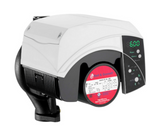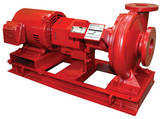Solve your water woes with Bladder and Diaphragm Expansion Tanks
Solve your water woes with Bladder and Diaphragm Expansion Tanks
How do bladder pressure tanks work?
When the water pressure changes, the volume of air in a bladder pressure tank contracts and expands. Time to time the amount of air in the tank should be measured and the tank recharged if the air is too low. Bladder pressure tanks do not provide any useful water storage capacity. Bell & Gossett Precharged Expansion Tanks come either with a bladder or a diaphragm to separate the air charge from the system water. These tanks can absorb the expansion forces of heating/ cooling system water and maintain proper system pressurization under varying operating conditions due to their designing.
Bladder tanks are needed in a closed loop heating or chilled water HVAC system to absorb the expanding fluid. It also limits the pressure within a heating or cooling system. A properly sized tank can for sure accommodate the expansion of the system fluid during the heating as well as the cooling cycle without the system exceeding critical pressure limits.
Compressed air is used by expansion tanks to maintain system pressures by either accepting or expelling the changing volume of water as it heats and cools. Few tank designs include a diaphragm or bladder to isolate the expanded water from the pressure controlling air cushion. It is pre-charged at the factory and can also be adjusted in the field to meet critical system requirements. The designer/specifying engineer can reduce tank sizes up to 80% by using this design and operation style for the expansion tank.
What functions do bladder pressure tanks serve?
Bladder pressure tanks help maintain a desired range of water pressure in the distribution system. They minimize pump cycling, preventing frequent starts and stops protecting facilities from damage. Bell & Gossett Bladder pressure tanks also protect against water hammer.
Waterlogged bladder pressure tank problems
A tank is considered to be waterlogged if it is totally filled with water or has too much water to function properly. Waterlogged bladder pressure tanks contribute too many problems. It can make the pump motor cycles turns on and off too often. This frequent cycling can shorten the lifespan of a pump. Ideally, pump motors should not cycle more than six times an hour. If your pump is cycling, it could be because the tank(s) is waterlogged. It can also lead to unacceptable coliform samples or taste and odor complaints. Because waterlogged tanks have stagnant water it can lead to bacterial problems or taste and odor complaints. A very common problem is premature tank failure. Water logging inside a tank can corrode and weaken the walls of the tank because of the exposure to water. Sometimes, it is better and more cost-efficient to replace a waterlogged tank than repair it.
How do Diaphragm tanks work?
The diaphragm tank allows the systems air cushion to be separated from the systems water. No waterlogging of the tank occurs because the air is held between the tank wall and the outside of a bladder placed inside the tank, and the system water is contained inside the bladder. This changes it to an air elimination system. Any air extracted from the system water is passed out of the system into the atmosphere. If the tank fails, the diaphragm cannot be replaced. The only advantage of this style is the low initial cost. The cost of replacing the bladder on smaller tanks may exceed the cost of replacing the tank.
How to use Diaphragm tanks
For booster applications, diaphragm tanks can be used on both the discharge and the suction manifold. When connected to the suction manifold, it serves to counteract fluctuating inlet pressures. Diaphragm tanks are most commonly used on the discharge manifold as they provide water storage for the system in very low flow situations. It not only decreases the running time of the booster pumps but also makes the system more energy efficient. These tanks are able to adjust to sudden pressure changes because the diaphragm is flexible. It also protects the tank from water hammering. A B&G diaphragm tank should be used to work in tandem with the Stop Function of the booster system when low or no flow conditions persist. At places where the inlet pressure fluctuates, Diaphragm tanks are installed on the suction manifold to reduce any damages caused by peak pressures.
Benefits of using Diaphragm pumps
A well maintained diaphragm pump will definitely cost less to operate over time. Diaphragm tanks are more energy efficient, as they use more motor torque on the foreword (power) stroke, but far less on the back stroke. You can overcome line pressure very easily with properly sized diaphragm pumps. There is a less danger of leakage; if a diaphragm metering pump is poorly maintained, it might lose its prime, but seldom leaks, or damages the surrounding area. However, at times these tanks might have issues with the diaphragm getting dislodged from the sides of the tank. This causes the water to flow into the compressed air chamber and prevents any pressure from building. If something like this happens, you will experience a major drop in water pressure and you might just have to replace your tank.
Recent Posts
-
The Bell & Gossett Ecocirc XL Pump
The Bell & Gossett Ecocirc XL Pump: Innovation in Efficiency and ReliabilityIntroductionIn the w …18th Jul 2024 -
The Efficiency of The Bell & Gossett Series e-1510 Centrifugal Pump
Bell & Gossett Series e-1510 centrifugal pumps are one of the most efficient pumps in the market …22nd Mar 2023 -
How Important Is The Bell & Gossett Expansion Tank
Bell & Gossett expansion tanks are an important component in any hydronic heating or cooling system. …20th Feb 2023



